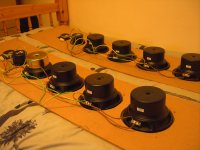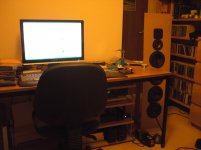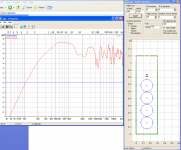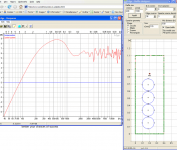Hi,
I decided to try some dipoles with cheapo drivers because:
1) They say you never go back [from dipole bass]
2) I heard some at last year's UK meet and they sounded interesting [Orions and some Goodmans with big drivers]
3) I have some cheap drivers that I was keen to experiment with
4) I wanted to learn about the differences in subjective quality between the common ported alignment and other bass alignments
5) It's a bit of fun to play around with speakers!
So to find out if dipoles might be for me, in my currently tiny bedroom, I decided to chop a 120cm x 60cm MDF board down the middle and insert some drivers.
I started with a 1" soft dome tweeter, 4" Audax poly mid/bass and a 7" "subwoofer" driver. These are things I have lying around.
The crossover initially consisted of a single 3.3uF Mundorf MKP capacitor in series with the tweeter.
The sound was listenable but poor, the midrange was too strong. I experimented with padding the 4" driver and found a combination of 2.7R in series followed by 13R in parallel produced a fairly balanced midrange and treble.
The bass was lacking big time. Clearly 30cm is far too narrow for a dipole speaker without EQ. To see what would happen I added more bass drivers.
I used a series-parallel wiring scheme to produce a nominal 4 ohm load for my four 7" bass drivers.
I am aware that series driver connection is a poor choice due to increased inductance, lessened amplifier damping and possibly even additional problems. This has to be balanced up against possible benefits of utilising additional bass units (increased power handling, lowered THD and IMD due to reduced power per driver and reduced excursion).
I also had a "hunch" that more bass units would somehow give more bass.... it did! The sound is terrific - exceptionally dynamic considering my small listening space and full of "life" and detail. All I need is a little more bass weight & extension and I could live with this sound forever. As a lesser point I do have some audible colouration from the flimsy and vibrating baffle.
Pictures to follow.
Simon
I decided to try some dipoles with cheapo drivers because:
1) They say you never go back [from dipole bass]
2) I heard some at last year's UK meet and they sounded interesting [Orions and some Goodmans with big drivers]
3) I have some cheap drivers that I was keen to experiment with
4) I wanted to learn about the differences in subjective quality between the common ported alignment and other bass alignments
5) It's a bit of fun to play around with speakers!
So to find out if dipoles might be for me, in my currently tiny bedroom, I decided to chop a 120cm x 60cm MDF board down the middle and insert some drivers.
I started with a 1" soft dome tweeter, 4" Audax poly mid/bass and a 7" "subwoofer" driver. These are things I have lying around.
The crossover initially consisted of a single 3.3uF Mundorf MKP capacitor in series with the tweeter.
The sound was listenable but poor, the midrange was too strong. I experimented with padding the 4" driver and found a combination of 2.7R in series followed by 13R in parallel produced a fairly balanced midrange and treble.
The bass was lacking big time. Clearly 30cm is far too narrow for a dipole speaker without EQ. To see what would happen I added more bass drivers.
I used a series-parallel wiring scheme to produce a nominal 4 ohm load for my four 7" bass drivers.
I am aware that series driver connection is a poor choice due to increased inductance, lessened amplifier damping and possibly even additional problems. This has to be balanced up against possible benefits of utilising additional bass units (increased power handling, lowered THD and IMD due to reduced power per driver and reduced excursion).
I also had a "hunch" that more bass units would somehow give more bass.... it did! The sound is terrific - exceptionally dynamic considering my small listening space and full of "life" and detail. All I need is a little more bass weight & extension and I could live with this sound forever. As a lesser point I do have some audible colouration from the flimsy and vibrating baffle.
Pictures to follow.
Simon
I may also add a bit of crossover to the mid and bass, but then it's not an ultra-ultra-cheap project anymore (I'm using about £40 worth of parts so far). However, I'll spend more when I feel really sure a dipole approach suits me. I expect a cleaner sound can be had by controlling the response of the 4" driver and 7" drivers with 1st order filters. It must be said, however, that the 4" Audax driver is a smooth performer, easily blending with a tweeter all by itself!
I am in awe of the perception of speed, dynamics and precision offered by this type of speaker, but I worry it won't be able to play my rock CDs properly.
I will be doing more research on dipoles and will look at widening the baffles or adding wings to the back. I don't yet know how much can be added to the sides (protruding backward) without causing a resonance issue.
Simon
I am in awe of the perception of speed, dynamics and precision offered by this type of speaker, but I worry it won't be able to play my rock CDs properly.
I will be doing more research on dipoles and will look at widening the baffles or adding wings to the back. I don't yet know how much can be added to the sides (protruding backward) without causing a resonance issue.
Simon
Ok, I've had the chance to listen more, and I think I got carried away saying how good this speaker is. It's good at some things, yes, but the tone really isn't anywhere near good enough yet.
Female vocals sound very coloured with an upper emphasis. I might attribute this to the 6khz peak in the Audax aerogel driver. Some crossover will be needed here I feel. Odd that in the ported box this problem doesn't really occur - I can only put that down to the balance of bass and midrange and how this affects the listener's perception of tone. Or could it be the bitumen I slapped on the driver reducing some resonance problem? I doubt it, but I could try. Run-in could be another factor, these drivers are all fresh out of the box.
Clearly there's some need to chop the top and bottom off the 4" driver. I will do that at about 4khz and 400hz, I think that will get the sound working out ok and not require expensive components. I think I can find enough film and bipolar electrolytics to make up the 66uF cap required. I will have to buy some coils of about 1.6mH to cut the bass drivers off at ~400hz.
I'll need about 0.25mH for the low-pass filter on the 4" Audax. This should leave about enough energy in the peaked area to mix nicely with the tweeter. I'll probably buy bigger and unwind to suit. I suspect the tweeter might then need tweaking to match, perhaps with another 1uF to bring it down. I do like them crossed high though, for no harshness.
Simon
Female vocals sound very coloured with an upper emphasis. I might attribute this to the 6khz peak in the Audax aerogel driver. Some crossover will be needed here I feel. Odd that in the ported box this problem doesn't really occur - I can only put that down to the balance of bass and midrange and how this affects the listener's perception of tone. Or could it be the bitumen I slapped on the driver reducing some resonance problem? I doubt it, but I could try. Run-in could be another factor, these drivers are all fresh out of the box.
Clearly there's some need to chop the top and bottom off the 4" driver. I will do that at about 4khz and 400hz, I think that will get the sound working out ok and not require expensive components. I think I can find enough film and bipolar electrolytics to make up the 66uF cap required. I will have to buy some coils of about 1.6mH to cut the bass drivers off at ~400hz.
I'll need about 0.25mH for the low-pass filter on the 4" Audax. This should leave about enough energy in the peaked area to mix nicely with the tweeter. I'll probably buy bigger and unwind to suit. I suspect the tweeter might then need tweaking to match, perhaps with another 1uF to bring it down. I do like them crossed high though, for no harshness.
Simon
Attachments
Just so people can see what we're dealing with, here's the right hand speaker in situ. Note the flexing baffle, due to the heavy combined driver weight. The other speaker is bang up to the left-hand wall and farily close to the rear wall. I suspect more bass will come from this side, but thankfully it's not obvious when actually listening to music.
Simon
Simon
Attachments
What is the Q on the 7"? I wonder if you might be starting out with too complex a setup. Do you have any 5" or larger highish Q fullranges lying about? I started out with a pair of 8" console stereo salvages in a 2'x3' baffle and was astonished at the perfomance. If you could do something similar and then tweek from there it might work out a little better.
My initial setup required a little help on the top end which a cap connected tweeter took care of nicely. The bass was there but not strong so a sub was added. This worked well enough for me to embark on a prettier setup. Currently I bi amp a 5.25" bi-cone FR with a 10" high Q helper woofer. A 12" sealed woofer takes care of the really low stuff. Working on polishing this buy designing a proper crossover and better treble amp.
My initial setup required a little help on the top end which a cap connected tweeter took care of nicely. The bass was there but not strong so a sub was added. This worked well enough for me to embark on a prettier setup. Currently I bi amp a 5.25" bi-cone FR with a 10" high Q helper woofer. A 12" sealed woofer takes care of the really low stuff. Working on polishing this buy designing a proper crossover and better treble amp.
mashaffer said:What is the Q on the 7"? I wonder if you might be starting out with too complex a setup. Do you have any 5" or larger highish Q fullranges lying about? I started out with a pair of 8" console stereo salvages in a 2'x3' baffle and was astonished at the perfomance. If you could do something similar and then tweek from there it might work out a little better.
Hi Mike,
I entirely agree that it could be too much for me to get right at once. I'm really just playing with parts I already have so far, which is how I've arrived at a 3-way.
Sadly I have no full range drivers, but it's funny you mention them, as this was intended to be a precursor to a possible 2-way (or 3 way with "helper tweeter" if necessary) using a CSS 4" full ranger - the one that everyone here seems to like. I'd run the CSS with just a cap in series to relieve it of some bass duties, then some of these 7" drivers (I have dozens of them, bought very cheaply). If it works I'd consider moving up to PA bass drivers and active biamping, but one step at a time.
For now I'm set of messing with these drivers I have as I feel they're just about smooth enough to get away with 1st order filters and show a lot of promise in terms of dynamics, sweetness, and even a glimpse of good bass (it's just a bit too rolled off with these 30cm wide baffles).
Any thoughts on my proposed x-over frequencies? I know the 400hz is in a fairly critical zone for male voices and other instruments, but hopefully the ear won't be sensitive enough there to notice any slight imperfections. Certainly the Audax mid will be covering a nice, wide range.
Simon
mashaffer said:What is the Q on the 7"?
Right, samples of these drivers were kindly measured by Vikash from this forum. Top guy!
The Qts I have listed here is 0.4 - quite low for open-baffle isn't it?
I have wondered about the series-parallel configuration and how this might cause a "slowed" bass response, which might explain why I suddenly got almost acceptable bass by connecting 4 together.
If I choose a series coil of high resistance will this alter the Q significantly?
Thanks,
Simon
Of course the crossover will depend a lot on what the drivers like. I prefer 200 or lower and 8k or higher in general however depending on the drivers and the slope other options may work fine.
I like to let the MR run free if possible but unless it is really a FR that may not work. If your mid has a gradually rising response as many seem to you could put a first order LP right where the rise starts in order to flatten it out. Then roll in the tweeter where the resulting response starts to fall off.
Myself I am going the active route for various reasons.
Yes .4 is quite low. I like .8 or better in most cases especially with smaller drivers like that. Added resistance will increase Qes. I can't remember the exact formula but it is out there. In any case when starting at .4 you have quite a long way to go so it may not help as much as one would like.
I like to let the MR run free if possible but unless it is really a FR that may not work. If your mid has a gradually rising response as many seem to you could put a first order LP right where the rise starts in order to flatten it out. Then roll in the tweeter where the resulting response starts to fall off.
Myself I am going the active route for various reasons.
Yes .4 is quite low. I like .8 or better in most cases especially with smaller drivers like that. Added resistance will increase Qes. I can't remember the exact formula but it is out there. In any case when starting at .4 you have quite a long way to go so it may not help as much as one would like.
There is a reference in Dickasons cookbook to raising the "Q" of a driver by adding resistance in the form of thin speaker cloth glued to the back of the basket, never tried it myself.
From my own cheap experiments with open baffle, the higher the "Q" of the driver the better the overall sound.
perhaps those particular woofer drivers would be better used in a
"Di-pole" box, 2 front and two firing to the back, I am definitely liking the sound of open back mids, though myself I'd tend to use a second order on the mid and come down a little more, 250Hz or so
From my own cheap experiments with open baffle, the higher the "Q" of the driver the better the overall sound.
perhaps those particular woofer drivers would be better used in a
"Di-pole" box, 2 front and two firing to the back, I am definitely liking the sound of open back mids, though myself I'd tend to use a second order on the mid and come down a little more, 250Hz or so
Simon,
What is the baffle size and have you simulated it? Just from the looks it seems very narrow for an OB so the dipole rolloff would begin at fairly high frequency?
Just a personal experience, the narrowest I could use was 45cm. This will give about 50-100Hz, and if equalised actively can go down to 30-40 Hz.
What is the baffle size and have you simulated it? Just from the looks it seems very narrow for an OB so the dipole rolloff would begin at fairly high frequency?
Just a personal experience, the narrowest I could use was 45cm. This will give about 50-100Hz, and if equalised actively can go down to 30-40 Hz.
mashaffer said:Of course the crossover will depend a lot on what the drivers like. I prefer 200 or lower and 8k or higher in general...
...If your mid has a gradually rising response as many seem to you could put a first order LP right where the rise starts in order to flatten it out. Then roll in the tweeter where the resulting response starts to fall off...
... .4 you have quite a long way to go so it may not help as much as one would like.
Thanks for the reply Mike.
I can see why you'd like the midrange to do a wideband, and it's a philosophy I fully subscribe to.
The mid rises sharply at about 5-6khz, so I intend to roll it off from 3800hz or so, and bring the tweeter in at 5-6khz.
The drivers are quite low Q then, but I have em (über-cheaply) so I'm gonna try working with them!
Simon
Moondog55 said:There is a reference in Dickasons cookbook to raising the "Q" of a driver by adding resistance in the form of thin speaker cloth glued to the back of the basket, never tried it myself.
From my own cheap experiments with open baffle, the higher the "Q" of the driver the better the overall sound.
perhaps those particular woofer drivers would be better used in a
"Di-pole" box, 2 front and two firing to the back, I am definitely liking the sound of open back mids, though myself I'd tend to use a second order on the mid and come down a little more, 250Hz or so
Fascinating engineering solutions and I don't want to dismiss the ideas lightly but they're perhaps a little "exotic" for this project at this early stage. Things I could try after widening the baffle and adding crossovers perhaps?
You're another one for a lower xover on the mid/bass transition then. I ordered some coils, including a couple of 1.8mH, which should put the x-over somewhere around 300hz - 350hz. If needs be I can order more coils, I have a cheap source for them and am only buying the cheapest until I have found sensible filter component values.
gainphile said:Simon,
What is the baffle size and have you simulated it? Just from the looks it seems very narrow for an OB so the dipole rolloff would begin at fairly high frequency?
Just a personal experience, the narrowest I could use was 45cm. This will give about 50-100Hz, and if equalised actively can go down to 30-40 Hz.
The baffle width is 30cm or 12", it's extremely narrow for sure, but also the very widest that fits in my tiny room either side of my "computer desk".
I'm going to hack my desk down and allow for maybe 40cm baffles, when I get some dry weather!
I haven't simulated the baffle, can you recommend any easy to use software?
Thanks for all the useful replies.
Simon
Question that I seem to be having trouble finding the answer to...:
In a series-parallel wiring of 4 4ohm drivers, what's the sensitivity change?
I initially thought it stayed the same (as the impedance does) but my bass increased a lot, and of course there's 4x the radiating area, but I can't see any way to work it out!
Am I gaining 3dB for each doubling of cone area? So 6dB gain in total?
Thanks
Simon
In a series-parallel wiring of 4 4ohm drivers, what's the sensitivity change?
I initially thought it stayed the same (as the impedance does) but my bass increased a lot, and of course there's 4x the radiating area, but I can't see any way to work it out!
Am I gaining 3dB for each doubling of cone area? So 6dB gain in total?
Thanks
Simon
Moondog55 said:Part of it ( I think ) is the increased resistance raising the "Q" of the driver, and if the DCR of the coil is highish then then it will change again
My overrall impedance is the same as for one. The cheap coil will have considerable DCR, which I don't consider to be a drawback in this speaker. Hopefully it won't be many days before I have these and install them, and I will be sure to report my findings here.
In the meantime I need to get chopping my desk down and widening the baffles!
Simon
SimontY said:
I haven't simulated the baffle, can you recommend any easy to use software?
Thanks for all the useful replies.
Simon
I use this:
http://www.tolvan.com/edge/help.htm
gainphile said:
Downloaded and playing now, excellent!
Moondog55 said:Try wings on the side first 100/150mm deep
Brilliant, ok. Still need to chop my desk though lol
Here are the same drivers, slightly offset, on a 40cm baffle.
Judging from where the response dips to 0dB, I'd say this arrangement will provide about another 20hz extension, which should make a very substantial improvement. The upper midrange is smoother too, which may or may not audibly improve the region slightly beyond the crossover point (first order so problems at 1500hz might be audible).
Judging from where the response dips to 0dB, I'd say this arrangement will provide about another 20hz extension, which should make a very substantial improvement. The upper midrange is smoother too, which may or may not audibly improve the region slightly beyond the crossover point (first order so problems at 1500hz might be audible).
Attachments
- Status
- This old topic is closed. If you want to reopen this topic, contact a moderator using the "Report Post" button.
- Home
- Loudspeakers
- Multi-Way
- My dipole experiment



